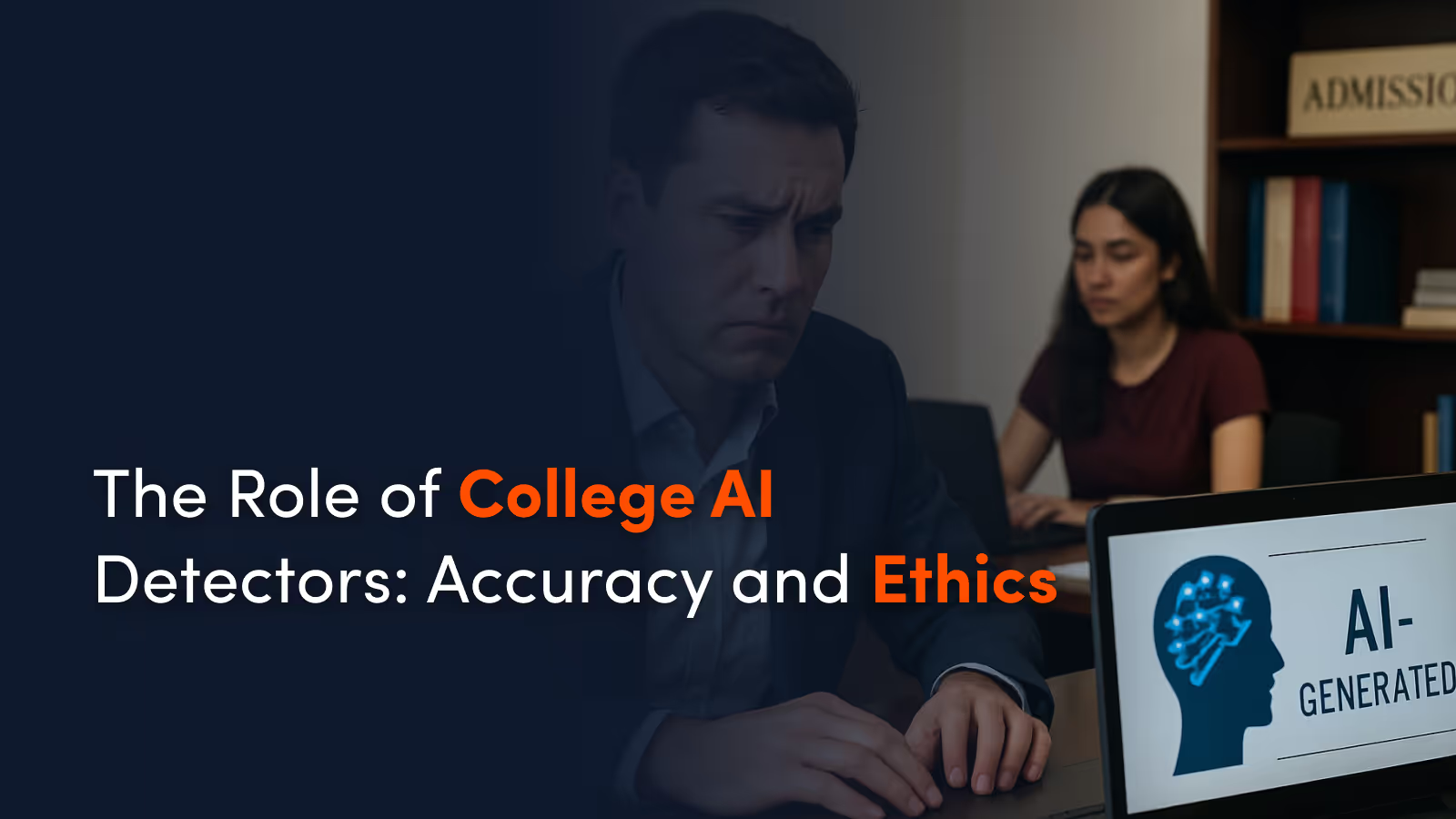About the Blog
As AI writing tools like ChatGPT become more mainstream, higher education institutions are racing to keep up. One of the most controversial developments? The growing use of AI detection tools in college admissions and academic settings. This blog explores how AI detectors work, their reliability and the big questions colleges are facing about fairness, ethics, and policy as they navigate this rapidly changing landscape.
Key Takeaways
- AI detectors are increasingly used in both admissions and academics to identify AI-generated writing, though not without controversy.
- Detection tools rely on linguistic analysis like perplexity and burstiness but are still prone to false positives and bias.
- Universities lack consistent policies around AI-generated content, creating confusion and inconsistency for applicants and students.
- Ethical and fairness concerns are growing, especially when it comes to non-native English speakers and student privacy.
The Role of AI Detectors in College Admissions
AI detection tools are becoming more common in both admissions and academic integrity workflows. These tools are designed to identify text that may have been generated by large language models (LLMs) like ChatGPT, to maintain fairness and authenticity in student evaluation. In admissions, this means checking essays and statements for signs of AI authorship.
The technology behind these tools analyzes linguistic features such as perplexity (how predictable the language is) and burstiness (how sentence length and structure vary). Human writing tends to be more erratic and inconsistent, while AI-generated content often exhibits smoother patterns. This gives detectors clues about whether a human or machine likely wrote the piece.
Some of the most widely used tools in education today include Turnitin's AI detection feature, GPTZero, and Originality.ai. Each takes a slightly different approach but generally uses AI models to score the likelihood that a text was written by another AI. These tools are becoming increasingly embedded into learning management systems and admissions workflows.
AI Detectors in the College Application Process
As college application season ramps up, admissions teams are grappling with how to assess personal statements in the age of AI. Some institutions have begun experimenting with AI detection tools to screen application essays, raising questions about transparency, bias, and student trust.
Why the concern? Admissions essays are meant to showcase an applicant’s unique voice, personal experiences, and critical thinking. If a student uses AI to draft their statement, it may not reflect their true writing ability or personal story—making it harder for admissions officers to evaluate them fairly.
Still, there’s a lack of consistency when it comes to policy. While a few universities have released guidelines discouraging or prohibiting AI-assisted applications, many remain silent on the issue. The result is a confusing landscape where students are unsure what’s allowed, and institutions are left to interpret AI use on a case-by-case basis.
AI Detection in Academic Integrity and Coursework
Beyond the admissions office, AI detection is playing a larger role in classrooms, particularly in writing-heavy disciplines. Faculty and academic integrity officers are using these tools to evaluate coursework for signs of AI involvement, raising new questions about how we define authorship and learning.
AI-generated work is increasingly viewed alongside traditional forms of plagiarism. In some cases, submitting AI-generated content can result in academic penalties, just like copying another student’s work. However, without clear policies, enforcement is often inconsistent, leaving students unsure of the rules.
There’s also a deeper philosophical debate happening: Should AI-assisted learning be embraced as a tool, or rejected as a shortcut? Many educators agree that institutions need updated, transparent policies to guide students and faculty through this new era of learning and content creation.
Accuracy and Limitations of College AI Detectors
While AI detection tools offer a promising way to flag questionable content, they are far from foolproof. One of the biggest challenges is accuracy—particularly the risk of false positives, where human-written work is mistakenly flagged as AI-generated. This can be damaging, especially in high-stakes contexts like admissions or academic misconduct hearings.
The core issue is that AI detectors work based on probabilities and patterns. They can estimate how "AI-like" a piece of writing is, but they can't offer a definitive answer. These tools often struggle with content written by non-native English speakers or students with atypical writing styles, increasing the chances of unfair flagging.
Given these limitations, colleges must use caution when making decisions based solely on AI detection results. Relying too heavily on these tools without human oversight risks undermining the trust between students and institutions—and could lead to real-world consequences for students who haven’t actually done anything wrong.
How Accurate Are AI Detectors?
Recent studies show that the accuracy of AI detectors can vary significantly. While some claim up to 98% accuracy under ideal conditions, real-world performance is often much lower—especially when analyzing short-form or well-edited content. In one independent review, OpenAI’s own AI classifier correctly identified only 26% of AI-written content.
Factors that affect detection accuracy include the complexity of the language, the type of writing (e.g., academic essay vs. creative writing), and the AI model used to generate the content. Short texts, in particular, are notoriously difficult to analyze reliably.
Real-world examples continue to highlight the tools’ limitations. In some cases, students have been falsely accused of using AI, only to later prove their innocence. These incidents underscore the need for additional context, multiple sources of evidence, and a more nuanced approach to using detection tools in high-stakes decisions.
Can AI Detectors Be Tricked?
Yes—and students are already experimenting with ways to do just that. From paraphrasing tools and rewriting prompts to inserting intentional grammar errors, there are growing strategies for bypassing AI detectors. Some even use “humanizing” tools that rewrite AI-generated content to mimic human quirks and unpredictability.
Why take the risk? For many students, AI tools are appealing shortcuts, especially under pressure. They may believe the benefits outweigh the risks, particularly if they see others using AI without facing consequences. This creates a cycle of use, evasion, and detection that’s hard for schools to break.
Meanwhile, AI tools themselves are evolving fast. Newer models are designed to sound more human, use more natural sentence structures, and even imitate specific writing styles. This arms race between generation and detection is likely to intensify, making it harder for institutions to draw clear lines between acceptable and unacceptable use.
Ethical and Fairness Concerns in AI Detection
AI detection raises serious concerns about bias, particularly toward non-native English speakers. Because many detection models are trained on English-language content with certain stylistic norms, they may flag writing that deviates from those patterns—even if it’s entirely human-written.
Another layer of complexity is data privacy. Some AI detectors store uploaded student content in databases for future comparison. Without explicit consent, this can raise red flags about ownership, surveillance, and data misuse. Students may not fully understand where their work goes or how it's being used after submission.
Perhaps the most pressing concern is fairness. A single false positive can have major consequences for a student’s academic record or admission status. Colleges must ensure any policy involving AI detection includes room for appeal, transparency in scoring, and human review. Only then can AI be integrated responsibly into the academic ecosystem.
Should Colleges Rely on AI Detectors for Admissions?
There are compelling arguments on both sides. Proponents of AI detection tools believe they’re essential for maintaining fairness and upholding academic standards. If students are using AI to gain an unfair advantage, institutions have a right to know and respond.
But critics caution against overreliance. The risks of misjudgment, bias, and data misuse may outweigh the benefits—especially when detection tools aren't 100% reliable. There's also a risk that an overly punitive approach could stifle student creativity or disproportionately impact marginalized groups.
Instead of leaning too hard on AI detectors, colleges might explore alternative authenticity checks—like timed writing samples, personal interviews, or follow-up essay questions. These methods offer more human-centered ways to evaluate applicants without relying solely on automated tools.
The Future of AI Detection in Higher Education
As AI writing tools continue to evolve, detection technology will have to keep up. Expect AI detectors to become more sophisticated, but also more scrutinized—for accuracy, fairness, and transparency. This ongoing evolution will shape how institutions define originality, authorship, and academic integrity.
Policy shifts are also on the horizon. Universities may soon implement clearer guidelines around AI use in applications and coursework, with more emphasis on transparency and student education rather than strict punishment. Expect more nuance in what’s considered acceptable AI assistance—such as using AI for brainstorming but not writing.
Ultimately, the future lies in adapting with intention. Higher ed must find ways to embrace helpful AI tools while maintaining standards of fairness and academic integrity. This balance will be key in preparing students for a world where AI is not only present—but inevitable.
Curious how colleges are navigating the AI revolution? Dive deeper into these conversations and more with Enrollify’s resources on AI in higher education. Stay informed and empowered—subscribe to our newsletter or explore more articles on enrollment marketing, ed tech, and the future of learning.
Frequently Asked Questions
What AI detectors do college admissions use?
Some institutions use tools like Turnitin, GPTZero, and Originality.ai to screen essays for AI-generated content.
How good are college AI detectors?
AI detectors are improving but still face accuracy issues, especially with short or stylistically unique writing—false positives and negatives are a real concern.










